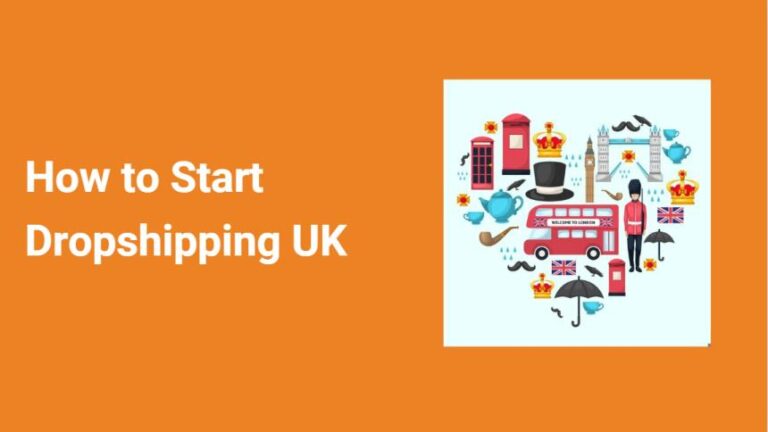The global dropshipping market size was valued at USD 365.67 billion in 2024 and is projected to reach USD 1,253.79 billion by 2030, growing at a CAGR of 22.0% from 2025 to 2030. Meanwhile, The UK e-commerce market is booming—Statista projects it will reach £275.4 billion in 2025, with a projected CAGR of 8.3% through 2030 (up from 7.9% in 2024). Dropshipping has emerged as a low-risk way to tap into this lucrative market, requiring minimal upfront investment and no inventory management. Whether you’re a startup or an established business looking to expand, this guide breaks down how to start dropshipping in the UK legally, profitably, and efficiently.
Why Dropship in the UK?
Dropshipping in the UK stands out for its unique blend of market demand, logistical ease, and policy transparency—making it an ideal choice for entrepreneurs worldwide.
- High Consumer Purchasing Power: The UK ranks among Europe’s top e-commerce markets, with an average per capita online spending of £1,200 annually. Over 38% of UK shoppers buy from international dropshipping stores, valuing variety and convenience.
- Streamlined Logistics: The UK’s robust delivery network (Royal Mail, DPD, Hermes) ensures domestic shipping within 1–3 days and EU deliveries in 2–5 days. Partnering with UK-based suppliers eliminates long shipping times, a top reason for cart abandonment.
- Favorable Regulations: Unlike some countries, the UK has no specific bans on dropshipping. Its clear legal framework provides certainty for both sellers and buyers.
- Platform Support: Major e-commerce platforms like Shopify, Amazon UK, and eBay UK cater to dropshippers with simplified onboarding, built-in payment gateways, and UK-specific marketing tools.
Is Dropshipping Worth It in the UK?

Absolutely—dropshipping in the UK offers a compelling return on investment, especially for those prioritizing low risk and flexibility.
- Low Startup Costs: You can launch a UK dropshipping business with just £500–£1,500. This covers platform fees (e.g., Shopify’s Basic plan at £25/month), domain registration (£10–15/year), initial marketing, and VAT registration (if required).
- Strong Profit Margins: Popular UK dropshipping categories boast 30–50% profit margins. The best dropshipping products UK 2024 include sustainable home goods (bamboo cutlery, biodegradable storage), smart small appliances (portable coffee makers, mini humidifiers), and personalized pet products (custom collars, automatic feeders).
- Risk Mitigation: Without inventory, you avoid the cost of unsold stock. You can test products quickly using tools like Google Trends or Jungle Scout UK, pivoting to high-demand items without financial loss.
- Scalability: As your business grows, you can expand to EU markets using the UK’s strategic location, or partner with more suppliers to diversify your product range.
Is Dropshipping Legal In The UK?

Yes, dropshipping is legal in the UK—provided you adhere to key regulations and operate transparently.
- Core Legal Requirements:
- Comply with the Consumer Rights Act 2015: This mandates clear product descriptions, 14-day “cooling-off period” for returns, and full refunds for faulty or misrepresented goods.
- Product Safety: Avoid selling counterfeit, banned, or regulated items (e.g., knives, or medical devices may require additional certifications).
- Data Protection: Follow GDPR rules by disclosing how you collect and use customer data (e.g., email addresses for marketing).
- Tax Compliance: If your annual turnover exceeds £85,000, you must register for a VAT number with HMRC and charge 20% VAT on sales to UK customers. Even below this threshold, voluntary VAT registration can enhance credibility with suppliers and customers.
How to Start Dropshipping UK: 6 Step-by-Step Guide
Step 1: Conduct Market Research & Choose Profitable Products

Low cost dropshipping UK success starts with smart product selection. Focus on:
- Lightweight, Small Items: Reduce shipping costs and delivery times (e.g., phone accessories, beauty tools, or home organizers).
- Medium Competition: Use tools like Google Keyword Planner, eBay UK’s “Trending” section, or Jungle Scout to find products with search volume but not oversaturated markets.
- High Demand Indicators: Look for products with 4+ star ratings, consistent sales trends, and social media buzz (e.g., TikTok viral items).
Step 2: Find Reliable UK Dropshipping Suppliers
Partnering with trustworthy UK dropshipping suppliers for small business is critical to avoiding delays and customer complaints.
- Top Supplier Channels:
- UK-Based Platforms: SaleHoo UK, Dropship UK, and TradeWheel UK (curated lists of verified local suppliers).
- Global Suppliers with UK Warehouses: AliExpress UK Warehouse, Oberlo, or CJ Dropshipping (offers faster shipping than overseas suppliers).
- Supplier Screening Criteria:
- UK-based warehousing for faster delivery.
- Clear return and refund policies (aligned with UK consumer law).
- Transparent pricing (no hidden fees) and minimum order quantities (MOQs).
- Positive reviews from other dropshippers (check Trustpilot or supplier forums).
Step 3: Build Your E-Commerce Store
Dropshipping on Shopify UK is the most popular choice, but you can also use Amazon UK, eBay UK, or WooCommerce.
- Store Setup Tips:
- Choose a UK-focused domain name for credibility.
- Optimize product pages with keyword-rich English descriptions and high-quality images.
- Integrate UK-friendly payment gateways: PayPal, Stripe, or Klarna (supports “buy now, pay later” options popular in the UK).
- Add a clear “Shipping & Returns” page outlining delivery times (e.g., “2–3 days UK delivery”) and the 14-day cooling-off period.
Step 4: Complete Legal & Tax Registration

Ensure compliance to avoid fines or business closure.
- VAT Registration: Apply via HMRC’s official website or use a tax agent. You’ll need to submit quarterly VAT returns (reporting sales and input VAT).
- Business Structure: Register as a sole trader (simple, low-cost) or limited company (better for scaling and liability protection).
- GDPR Compliance: Create a privacy policy page, obtain customer consent for marketing, and secure data with SSL encryption.
Step 5: Set Up Logistics & Customer Service
UK dropshipping logistics tips focus on speed and transparency—key to customer retention.
- Logistics Partnerships: Use UK-based couriers (Royal Mail, DPD) for domestic orders and DHL Express UK for EU shipments. Set up flat-rate shipping to simplify pricing.
- Customer Service: Offer 24-hour email support and a UK phone number (optional). Use chatbots to handle common queries (e.g., “Where is my order?”) and process returns efficiently.
Step 6: Market Your Dropshipping Business
Drive traffic to your store with UK-targeted marketing strategies.
- Free Traffic:
- SEO: Optimize your site for keywords like “how to start a dropshipping business in UK legally” and “best dropshipping products UK 2024.”
- Social Media: Post product demos on Instagram Reels and TikTok, or join UK e-commerce Facebook groups to promote your store.
- Paid Traffic:
- Google Ads: Run search campaigns for high-intent keywords (e.g., “buy sustainable home goods UK”).
- Facebook/Instagram Ads: Target UK audiences by age, location, and interests (e.g., “eco-friendly living” or “pet owners”).
- Word of mouth Marketing: Encourage customers to leave reviews (offer a 10% discount for future purchases) and partner with UK micro-influencers to promote your products.
What to Dropship in the UK: Top Categories & Trends
The UK dropshipping industry is expected to grow rapidly in the coming years, with 62% of UK consumers prioritizing eco-friendly purchases—making sustainability a non-negotiable factor for successful selection. Beyond general trending items, focus on these high-demand categories and attributes:
1. Sustainable Goods

Demand for eco-friendly products, plastic-free packaging, and ethically sourced goods spans multiple sectors, with 87% YoY growth in sustainable home and personal care:
- Fashion: Organic cotton clothing, recycled polyester activewear, vegan leather accessories (monthly searches: 4,200 for “sustainable UK fashion dropshipping”). Look for suppliers with GOTS (Global Organic Textile Standard) certification (e.g., EcoVillage UK, Ethical Trade UK).
- Home Decor: Bamboo kitchenware, upcycled furniture, soy wax candles (suppliers: Sustainable Home Goods, EcoHome UK). Highlight plastic-free packaging in product descriptions—49% of UK shoppers say packaging sustainability influences purchases.
- Personal Care: Plastic-free shampoo bars, cruelty-free skincare, refillable beauty products. Brands with Leaping Bunny or PETA certifications perform 32% better in UK search rankings.
2. Smart Wellness & Lifestyle Products
Post-pandemic, UK consumers continue investing in at-home wellness and convenience, with 63% YoY growth in smart wellness devices (Adobe Analytics 2025):
- Fitness: Portable yoga mats (recycled material), smart water bottles (track hydration), resistance bands (eco-friendly latex).
- Health: Wearable sleep trackers, air purifiers (small, lightweight for low shipping costs), herbal tea sets (ethically sourced).
3. Seasonal & Niche Items
Avoid oversaturated categories and target seasonal or hyper-specific needs:
- Winter: Sustainable woolen socks, reusable heated blankets (low energy consumption), eco-friendly Christmas decorations.
- Summer: Biodegradable sunscreen, foldable picnic blankets (waterproof), reusable straw sets (customizable with UK brand logos).
Key selection Tips
- Prioritize lightweight, small items to reduce shipping costs (e.g., skincare samples, jewelry) — average UK shipping costs for heavy items are 2.3x higher (Royal Mail 2025 Rate Card).
- Check competition levels: Use Jungle Scout UK to ensure fewer than 5,000 active sellers for your target product—higher competition means lower profit margins.
- Align with UK cultural trends: For example, 58% of UK households own pets, making personalized pet accessories (e.g., eco-friendly dog beds) a steady niche.
Frequently Asked Questions
Do I need a license to dropship in the UK?
No specific “dropshipping license” is required. However, you must comply with VAT registration (if turnover exceeds £85k), product safety regulations, and GDPR. For restricted items (e.g., knives, electronics), additional certifications may be needed.
How much does it cost to start dropshipping in the UK?
Initial costs range from £500–£1,500, covering platform fees (Shopify: £25/month), domain registration (£10–15/year), marketing budget, and VAT registration fees (if using an agent).
What are the best dropshipping suppliers in the UK?
Top options include UK-based suppliers like Wholesale2B UK and Dropship UK, plus global suppliers with UK warehouses . Always verify supplier reviews and delivery times.
How to handle VAT for dropshipping in the UK?
Register for a VAT number via HMRC, charge 20% VAT on UK sales, and submit quarterly VAT returns. For EU cross-border sales, use the One-Stop Shop (OSS) scheme to simplify tax filing.
Can I dropship on Amazon UK without a UK address?
Yes, but you’ll need to use a UK-based dropshipping supplier with local fulfillment or Amazon’s FBA (Fulfillment by Amazon) service to meet Amazon’s delivery requirements (e.g., 2-day UK shipping).
Conclusion
The UK e-commerce market—valued at £275.4 billion in 2025—offers huge potential for dropshippers, with low startup costs, trending niche products, and clear rules. To seize this, partnering with a trusted supply chain provider like NicheDropshipping is key, especially for sellers sourcing cost-effective, quality goods from China.
Aligned with their mission “Helping Every Online Business Who Values Product & Services Succeed,” NicheDropshipping delivers one-stop support for ready-to-scale UK sellers:
- Product Sourcing: Curated Chinese supplier network for UK-trending items (sustainable goods, tech accessories) at competitive prices.
- Brand & Fulfillment: Brand packaging, white/private labeling, plus global fulfillment centers to cut shipping costs and speed up delivery.
- Transparent Collaboration: Guided by “Customer First,” they’ve helped 1,000+ sellers scale orders, with honesty and clear communication (per founder Stanley Nieh’s approach).
Whether you’re a startup testing niche products or expanding sustainably, NicheDropshipping integrates with major platforms (e.g., Shopify) and handles cross-border challenges (customs, inventory) so you focus on sales.
Ready to scale? Visit NicheDropshipping for more, or get a free UK-market strategy plan!

